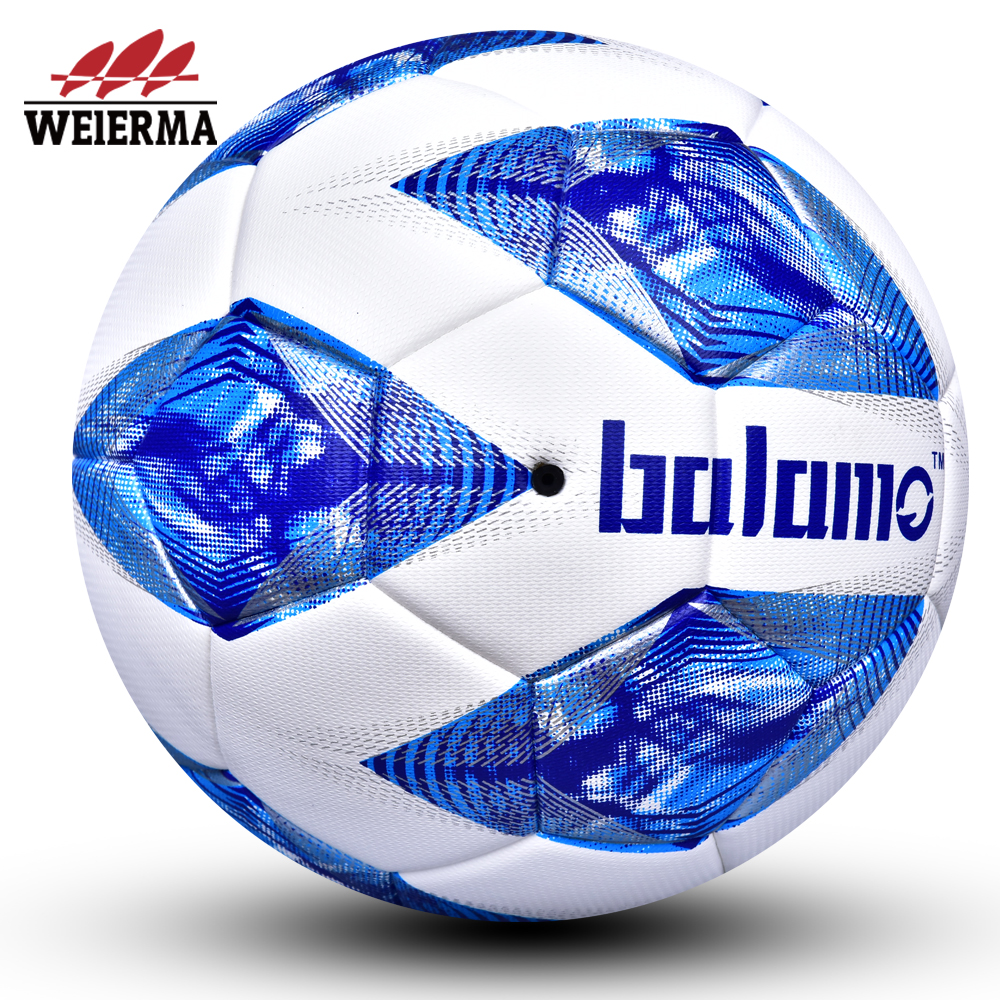Materjali erinevused: vastupidavus ja vastupidavus
Jalgpallide valikul määravad kasutatavad materjalid palli vastupidavuse ja vastupidavuse. Treeningjalgpallid on valmistatud materjalidest, mis on spetsiaalselt loodud pideva kasutamise kulumisele vastu pidama. Tavaliselt loovad tootjad ja tarnijad need pallid sünteetilisest nahast või vastupidavast plastist, tagades pikaealisuse ja kulumiskindluse kuudepikkuse intensiivse harjutamise jooksul. Teisest küljest on mängujalgpallid valmistatud lühemaks kasutamiseks, kuid nõuavad esmaklassilist materjali kvaliteeti, et mängu ajal jõudlust optimeerida. Nendes pallides kasutatakse sageli naturaalset nahka või kvaliteetseid sünteetilisi alternatiive, pakkudes suurepäraseid puutetundlikkust, mis talub erinevaid ilmastikutingimusi.
Vahtkihid: mõju palli jäikusele
Vahtkihtide lisamine jalgpallidesse täidab kahte eesmärki: suurendab vastupidavust ja mõjutab palli jäikust. Treeningjalgpallidel on sageli pinna all õhuke vahukiht, mis annab jäigema tekstuuri, mistõttu need sobivad korduvateks harjutusteks ja oskuste arendamiseks. Jäik olemus aitab palli kontrollida ja järjepidevust erinevates treeningtegevustes. Matšjalgpallid kasutavad aga paksemat vahtpolsterdust, mis mitte ainult ei kaitse palli, vaid annab ka pehmema tunde, muutes need ideaalseks mängutingimustes, kus puudutus ja täpsus on üliolulised. Tehased keskenduvad sageli nende kihtide optimeerimisele, et vastata mängijate spetsiifilistele vajadustele.
Kusepõie tüübid: butüül vs lateks
Butüülpõied: treeningjalgpallid
Treeningjalgpallidel on valdavalt butüülpõied, mis on tuntud oma suurepärase õhupidamisvõime poolest. See konstruktsioonivalik tagab, et pallid püsivad kindlad ja püsivad ühtlase rõhu pikema aja jooksul, vähendades täitmise sagedust. Mängijatele ja treeneritele tähendab butüülpõie töökindlus treeningute ajal vähem katkestusi. Tarnijad rõhutavad butüüli tähtsust treeningjalgpallide valmistamisel selle vastupidavuse ja kulu-efektiivsuse tõttu.
Latekspõied: tikujalgpallid
Seevastu mängujalgpallid on varustatud latekspõiega, mida hinnatakse nende pehmema puudutuse ja parema põrke tõttu. Kuigi latekspõied vajavad väiksema õhupeetuse tõttu sagedamini täitmist, tagab nende paindlikkus muruväljakutel tundlikkuse, hõlbustades paremat pallikontrolli ja mängudünaamikat. Tootjad tõstavad sageli esile latekspõie esmaklassilist kvaliteeti, et õigustada matšpallidega seotud kõrgemaid kulusid.
Pinna sobivus: mitmekülgsus treeningpallides
Treeningjalgpallid on loodud töötama hästi erinevatel pindadel. Alates murust ja kunstmurust kuni betooni ja siseruumideni – need pallid säilitavad oma funktsiooni ja vastupidavuse. Mitmekülgsus tuleneb elastsetest materjalidest, mida tehased tootmise ajal kasutavad, võimaldades mängijatel järjepidevalt treenida olenemata asukohast. Mängijalgpallid on aga optimeeritud kindlatele pindadele, peamiselt looduslikule murule, et tagada tipptulemus. Kohanemisvõime on vähem muret tekitav, kuna keskendutakse reguleeritud matšidele ainulaadsete mänguelementide maksimeerimisele.
Mõju kuludele: hind vs. jõudlus
Jalgpallide hinnakujundus on treening- ja mänguvalikute vahel märkimisväärselt erinev. Treeningjalgpallid on tavaliselt eelarvesõbralikumad, pakkudes kulutõhusat lahendust regulaarseks kasutamiseks. Tootmise mastaabisääst aitab kaasa nende taskukohasusele, muutes need klubidele ja koolidele kättesaadavaks. Vastupidi, mängujalgpallid on suurem investeering tänu esmaklassilistele materjalidele ja täpsele ehitusele, mis on vajalik võistlusstandarditele vastamiseks. Tarnijad turustavad neid palle, pannes rõhku nende täiustatud jõudlusomadustele, õigustades tõsiste mängijate ja professionaalide jaoks kõrgemat hinnapunkti.
Kasutamise sagedus: matš vs treening
Treeningjalgpallid on loodud pikaajaliseks kasutamiseks, rahuldades igapäevaste treeningute rangeid nõudmisi. Nende konstruktsioon võimaldab neil taluda sagedasi lööke ja puurimist ilma olulise kulumiseta. Matšjalgpallid on seevastu mõeldud piiratud kasutamiseks, tavaliselt reserveeritud ametlikuks mänguseadeks. Rõhk on kõrgeima jõudluse saavutamisel kogu matši vältel, kusjuures tootjad tagavad, et kõik komponendid, alates õmblusest kuni välismaterjalini, vastavad rangetele standarditele.
Tulemuslikkuse ootused: järjepidevus mängus
Mängijalgpallide puhul on esituse järjepidevus ülimalt oluline. Mängijad toetuvad palli ennustatavale käitumisele, et arendada strateegiaid ja sooritada mänge tõhusalt. Mängijalgpallides kasutatavad täpsed tootmisprotsessid ja kvaliteetsed materjalid seavad esikohale sellised omadused nagu lennu stabiilsus, põrge ja juhtimine, mis on võistlusmängus üliolulised. Seevastu treeningjalgpallid on loodud vastupidavaks, kuid nende jõudlusomadused on tasakaalustatud vastupidavusega, et taluda sagedast kasutamist ilma kiiresti halvenemata.
Inflatsioonivajadused: hooldus ja hooldus
Jalgpallide korralik hooldus on optimaalse soorituse tagamiseks hädavajalik. Butüülpõiega jalgpalli treenimine nõuab harvemat pumpamist, lihtsustades hooldusprotseduure ja pikendades palli eluiga. Mängijad ja meeskonnad hindavad sageli selliste vähese hooldusega pallide praktilisust. Latekspõiega matšjalgpallid nõuavad regulaarsemat tähelepanu ideaalse rõhutaseme säilitamiseks, mistõttu peavad mängijad olema hoolikamad. Tehased annavad sageli juhiseid tagamaks, et mängijad saavutavad oma jalgpallidest parima tulemuse.
Mõju mängustiilile: õige palli valimine
Valik matši ja treeningjalgpalli vahel võib oluliselt mõjutada mängija stiili ja tehnikat. Treeningpallid toetavad oma vastupidavuse ja jäikusega oskuste täiustamist ja füüsilist vormimist. Need pakuvad ühtlast jõudlust erinevatel harjutustel, võimaldades mängijatel tõhusalt arendada oma jalatööd ja pallikäsitlemise oskusi. Mängupallid vastavad aga võistlusmängu nüansilistele nõudmistele, pakkudes pehmuse ja reageerimisvõime segu, mis võib parandada mängija taktikalist sooritust mängude ajal.
Ostukaalutlused: kvaliteet ja kaubamärgi usaldus
Investeerideskohandatud noorte jalgpalls, mängijad ja organisatsioonid peaksid arvestama selliste teguritega nagu kvaliteet ja kaubamärgi maine. Tootjad, kes pakuvad erinevaid valikuvõimalusi, alates säästlikest treeningpallidest kuni esmaklassiliste matšpallideni, pakuvad mitmekülgsust jõudlust kahjustamata. Usaldus tarnija vastu on ülioluline, kuna see tagab mängijatele ostetud jalgpallide autentsuse ja usaldusväärsuse. Materjalide, ehituskvaliteedi ja varasemate kasutajate tagasiside hindamine võib suunata ostjaid teadlike otsuste tegemisel.
Weierma pakub lahendusi
Weierma pakub lahendusi, mis on kohandatud vastama nii amatöör- kui ka professionaalsete mängijate erinevatele vajadustele. Meie jalgpallivalik hõlmab nii treening- kui ka matšivõimalusi, tagades vastupidavuse, jõudluse ja taskukohasuse. Juhtiva tarnijana kohustub Weierma kasutama tööstusstandarditele vastavate ja ületavate jalgpallide tootmiseks kvaliteetseid materjale ja täiustatud tootmistehnikaid. Kas harjutamiseks või võistluseks, usaldage Weiermat, kes pakub usaldusväärseid ja suure jõudlusega jalgpall, mis parandab teie mängukogemust.
Postitusaeg: 2025-07-12 16:44:02


